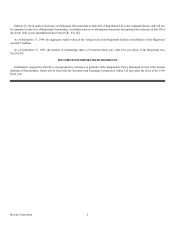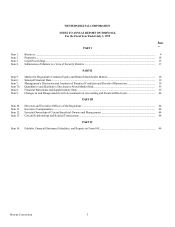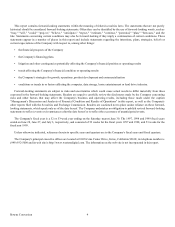Western Digital 1999 Annual Report Download - page 16
Download and view the complete annual report
Please find page 16 of the 1999 Western Digital annual report below. You can navigate through the pages in the report by either clicking on the pages listed below, or by using the keyword search tool below to find specific information within the annual report.Bowne Conversion 11
maintains ongoing contact with end users through primary and secondary market research, focus groups, product registrations and
technical support databases.
Competition
In the desktop product market, the Company competes primarily with Fujitsu, IBM, Maxtor, Quantum, Samsung, and Seagate. In the
enterprise market, the Company competes primarily with Fujitsu, Hitachi, IBM, Quantum, and Seagate.
The hard drive industry is intensely competitive, with hard drive suppliers competing for a limited number of major customers. Hard
drives manufactured by different competitors are highly substitutable due to the industry mandate of technical form, fit and function
standards. Hard drive manufacturers compete on the basis of product quality and reliability, storage capacity, unit price, product
performance, production volume capabilities, delivery capability, leadership in time-to-market, time-to-volume and time-to-quality and
ease of doing business. The relative importance of these factors varies among different customer and market segments. The Company
believes that it is generally competitive in all of these factors.
The Company believes that it cannot differentiate its hard drive products solely on attributes such as storage capacity; therefore,
the Company also differentiates itself by designing and incorporating into its hard drives desirable product performance attributes and
by emphasizing rapid response with its computer manufacturer and distribution customers and brand equity with its end users. These
product performance attributes include seek time, data transfer rates, intelligent caching, failure prediction, remote diagnostics,
acoustics and data recovery. Rapid response requires accelerated design cycles, customer delivery and production flexibility, which
contribute to customer satisfaction. Data storage has become strategically critical for computer end users. Consequently, the Company
believes that trust in a manufacturer's reputation has become an important factor in the selection of a hard drive, particularly within
such a rapidly changing technology environment. The Company believes it has strong brand equity with its end users.
During 1997, the Company significantly increased its market share in the desktop hard drive market. The Company's market share
eroded in 1998, primarily due to competitive conditions in the hard drive industry (with resulting cutbacks in production), the timing of
the Company's transition from thin film to magnetoresistive head technology and certain manufacturing and performance issues
encountered as the Company pushed thin film head technology to its limits. The Company completed its transition to magnetoresistive
technology in 1999 and began its transition to giant magnetoresistive technology; however, the competitive conditions in the hard
drive industry continued and the Company's market share eroded further due to cutbacks in production.
The desktop market is characterized by more competitors and shorter product life cycles than the enterprise market; therefore, it has
traditionally been subject to periods of sustained and severe price competition, and factors such as time-to-market can have a more
pronounced effect on the success of any particular product.
The enterprise portion of the hard drive market is more concentrated than the desktop portion, with the two largest competitors,
Seagate and IBM, having market shares approaching 40%. During the past two years price competition in the enterprise market has
increased, and the Company expects that it will continue to increase. Introduction of the WD Enterprise™ drives into the enterprise
market was successful because of high product quality, competitive product performance and the Company's ability to leverage its
customer and supplier relations from the desktop market; however, the Company's future success in the enterprise storage market is
heavily dependent on the successful development, timely introduction and market acceptance of new products.
The Company expects that the products under development by Connex will face significant competition from established
manufacturers of network attached storage devices. For an additional discussion of the challenges facing Connex, see Part II, Item 7,
under the heading "Risk factors related to Western Digital particularly."
Advances in magnetic, optical or other data storage technologies could result in competitive products that have better performance
or lower cost per unit of capacity than the Company's hard drive products. Some of the Company's competitors are developing hybrid
storage devices that combine magnetic and optical technologies, but the Company has decided not to pursue this technology at this
time. High-speed semiconductor memory could compete with the Company's hard drive products in the future. Semiconductor memory
is much faster than magnetic disk drives, but currently is volatile (i.e., subject to loss of data in the event of power failure) and much
more costly. Flash memory, a nonvolatile semiconductor memory, is currently much more costly and, while it has higher "read"
performance than disk drives, it has lower "write" performance. Flash memory could become competitive in the near future for
applications requiring less storage capacity than hard drives can provide.
























